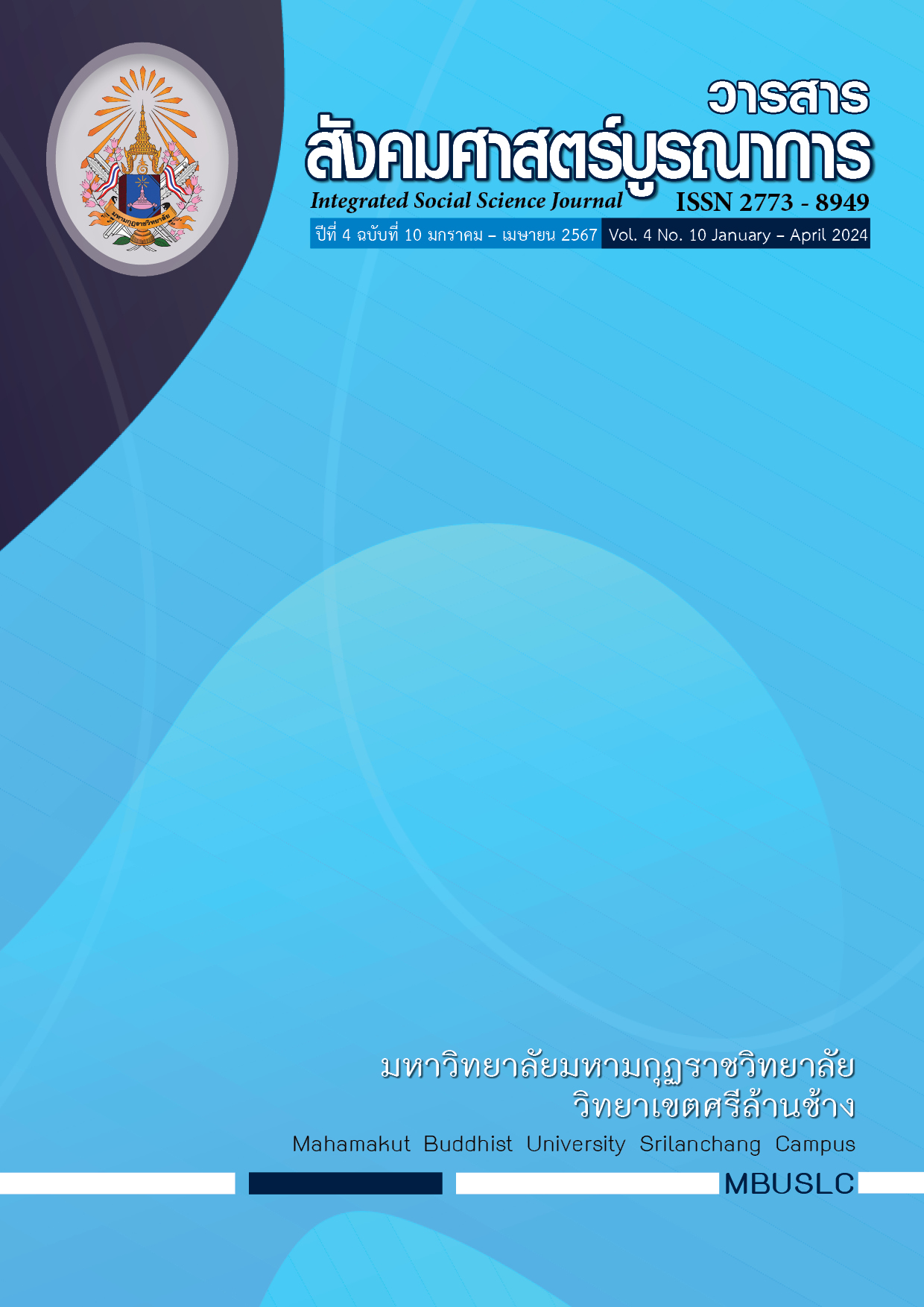VINAYA AND LAY PEOPLE : DISCIPLINARY GUIDELINES FOR RIGHT UNDERSTANDING
Main Article Content
Abstract
The four kinds of Buddhist assemblies were generally allowed to become the Buddha’s successors of Buddhism. Among them, the monks (Bhikkhu in Pali), the female monks (Bhikkhuni in Pali), were direct successors while lay people, both female and male, were regarded as indirect successors. In charge of responsibility, all the four Buddhist assemblies had to study and learn what was called the Doctrine and Discipline (Dhamma and Vinaya in Pali), followed it strictly and assist to propagate it and to resolve when there was any problem. It was also necessary for lay people to understand the monk’s discipline, accept and follow properly to prevent any mistake. The objective of the academic article was to explain some parts of the Discipline (Vinaya in Pali) that lay people should treat with the monks. The content of the Discipline was involved with the significance of the Discipline, lay people’s duties on Buddhism, some topics involved with lay people, lay people’s misunderstanding of the Discipline and the guidelines on prevention and resolution of offences on lay people. The significance of the Discipline was useful to give rise to faith and belief for lay people and to observe and sustain the Buddha’s teaching.
Article Details

This work is licensed under a Creative Commons Attribution-NonCommercial-NoDerivatives 4.0 International License.
บทความที่ได้รับการพิจารณาจากคณะกรรมการผู้ทรงคุณวุฒิและเผยแผ่ในวารสารฉบับนี้ เป็นทัศนคติและข้อคิดเห็นส่วนบุคคลของผู้เขียนแต่ละท่าน ไม่ถือว่าเป็นทัศนะคติและความรับผิดชอบ
ของบรรณาธิการ
บทความ ข้อมูล เนื้อหา รูปภาพ ฯลฯ ที่ได้รับการตีพิมพ์ในวารสารสังคมศาสตร์บูรณาการ ถือเป็นลิขสิทธิ์ของวารสารสังคมศาสตร์บูรณาการ หากบุคคลหรือหน่วยงานใดต้องการนำทั้งหมดหรือส่วนหนึ่งส่วนใดไปเผยแพร่ต่อหรือเพื่อกระทำการใด ๆ จะต้องได้รับอนุญาตเป็นลายลักอักษรจากวารสารสังคมศาสตร์บูรณาการ ก่อนเท่านั้น
References
กรมการศาสนา. (2525 ก). พระไตรปิฎกฉบับหลวง ภาษาไทย เล่มที่ 2. พระวินัยปิฏก เล่มที่ 2 มหาวิภังค์ ภาค 2. พิมพ์ครั้งที่ 4. กรุงเทพมหานคร: กระทรวงศึกษาธิการ
กรมการศาสนา. (2525 ข). พระไตรปิฎกภาษาไทย ฉบับหลวง เล่มที่ 5 พระวินัยปิฎก เล่มที่ 5 มหาวรรค ภาค 1. พิมพ์ครั้งที่ 4. กรุงเทพมหานคร: กระทรวงศึกษาธิการ
กรมการศาสนา. (2525 ค). พระไตรปิฎกภาษาไทย ฉบับหลวง เล่มที่ 5 พระวินัยปิฎก เล่มที่ 5 มหาวรรค ภาค 2. พิมพ์ครั้งที่ 4. กรุงเทพมหานคร: กระทรวงศึกษาธิการ
กรมการศาสนา. (2525 ง). พระไตรปิฎกภาษาไทย ฉบับหลวง เล่มที่ 7 พระวินัยปิฎก เล่มที่ 7 จุลวรรค ภาค 2. พิมพ์ครั้งที่ 4. กรุงเทพมหานคร: กระทรวงศึกษาธิการ
กรมการศาสนา. (2525 จ). พระไตรปิฎกฉบับหลวง ภาษาไทย เล่มที่ 8. พระวินัยปิฏก เล่มที่ 8 ปริวาร. พิมพ์ครั้งที่ 4. กรุงเทพมหานคร: กระทรวงศึกษาธิการ
กรมการศาสนา. (2525 ฉ). พระไตรปิฎกภาษาไทย ฉบับหลวง เล่มที่ 10. พระสุตตันตปิฎก เล่มที่ 2 ทีฆนิกาย มหาวรรค. พิมพ์ครั้งที่ 4. กรุงเทพมหานคร: กระทรวงศึกษาธิการ
พระธรรมกิตติวงศ์ (ทองดี สุรเตโช). (2550). พจนานุกรมเพื่อการศึกษาพุทธศาสน์ ชุดคำวัด. กรุงเทพฯ: โรงพิมพ์เลี่ยง เชียง
พระพรหมคุณาภรณ์ (ป.อ. ปยุตฺโต). (2554). พระไตรปิฎกสิ่งที่ชาวพุทธต้องรู้. ฉบับสองภาษา. พิมพ์ครั้งที่ 15 กรุงเทพฯ: สำนักพิมพ์จันทร์เพ็ญ
พระมหาโพธิวงศาจารย์ (ทองดี สุรเตโช). (2561). พระวินัยบัญญัติ. กรุงเทพฯ: บริษัทรุ่งศิลป์การพิมพ์ (1977) จำกัด
มหามกุฏราชวิทยาลัย. (2553 ก). พระไตรปิฎกพร้อมอรรกถกาแปล ชุด 91 เล่ม. พระวินัยปิฎก เล่มที่ 1 มหาวิภังค์ ภาค 1. พิมพ์ครั้งที่ 4. กรุงเทพมหานคร: มหามกุฏราชวิทยาลัย.
มหามกุฏราชวิทยาลัย. (2553 ข). พระไตรปิฎกพร้อมอรรกถกาแปล ชุด 91 เล่ม. พระวินัยปิฎก เล่มที่ 5 มหาวรรค ภาคที่ 2. พิมพ์ครั้งที่ 4. กรุงเทพมหานคร: มหามกุฏราชวิทยาลัย.
สมเด็จพระมหาสมณเจ้า กรมพระยาวชิรญาณวโรรส. (2511). นวโกวาท (หลักสูตรนักธรรมชั้นตรี). พิมพ์ครั้งที่ 62. กรุงเทพฯ: มหามกุฏราชวิทยาลัย
สมเด็จพระมหาสมณเจ้า กรมพระยาวชิรญาณวโรรส. (2541). พระวินัยมุข (เล่ม 1) หลักสูตรนักธรรมชั้นตรี. พิมพ์ครั้งที่ 39. กรุงเทพฯ: มหามกุฏราชวิทยาลัย
เสฐียรพงษ์ วรรณปก. (2553). คำบรรยายพระไตรปิฎก. พิมพ์ครั้งที่ 6. กรุงเทพฯ: ธรรมสภา
แสวง อุดมศรี. (2546). พระวินัยปิฎก 1 ว่าด้วยมหาวิภังค์หรือภิกขุวิภังค์. กรุงเทพฯ: บริษัทประยูรวงศ์ พริ้นท์ติ้ง จำกัด

